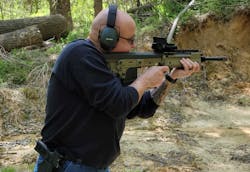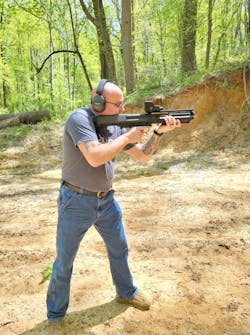KelTec “Short” Guns—Not Handguns
The KelTec RFB
Just over 20 years ago, the active shooter response movement crossed our nation. It was a necessary response to an unfortunate list of incidents but a side effect was that law enforcement agencies, even in anti-gun regions/areas, saw the need for patrol rifles. While many agencies (or more specifically, the political bodies controlling the agencies) resisted getting rifles by compromising on pistol-caliber carbines or purchasing pump-action rifles (in .308), plenty of agencies simply did some studying and adopted semi-automatic rifles in .223/5.56mm or .308. As in all urban conflict situations, the length of a rifle plays a role in how maneuverable it is in confined spaces.
This article appeared in the July issue of OFFICER Magazine. Click Here to view the digital edition. Click Here to subscribe to OFFICER Magazine.
Enter the bullpup configuration semi-automatic rifle, or more specifically, the KelTec Weapons Model RFB chambered in .308. RFB stands for Rifle Forward-ejecting Bullpup. Yes, that says “forward-ejecting.” Part of the challenge of making any rifle entirely ambidextrous (which the RFB is and we’ll take a closer look at that in a moment) is controlling the spent brass ejection so it works with shooters of either dominant hand. The RFB’s proprietary bolt design holds dual extractors that simultaneously extract empty brass and send it down the ejection chute as the bolt reciprocates. The ejection chute dumps the spent brass out the front of the weapon at the front of the fore end.
The published specifications say that the rifle weighs 8.7 pounds unloaded. While many will balk at that weight in a patrol rifle, let’s remember that it’s primary purpose is combat. If you’re carrying this rifle, you’re doing so in response to someone who is hunting innocents and killing for sport. Your duty is to move to the sound of shots and neutralize the bad guy(s). This rifle is ideally suited for that and eight pounds isn’t a big deal. It’s designed to feed ammo from the FN/FAL metric pattern 20-round magazines, has an 18.5” barrel length and a five pound trigger.
The primary controls, as mentioned, are 100% ambidextrous. In the photos you can easily see the Fire/Safe selector lever. The “F” for Fire is bright red on both sides of the weapon. The “S” for Safe is white. Take a look and you’ll see the small paddle magazine release at the back of the magazine well, easily reached by either hand.
On top of the receiver is roughly a foot of picatinny rail for mounting sights and optics. For our testing purposes we mounted a MeproLight Pro V2 optic, gathered up an assortment of available .308 ammo from Federal, Winchester and Hornady and headed for the range. The RFB proved easy to manipulate and shoot. Recoil was as expected for a .308 rifle but felt different from the typical AR style rifles we’d previously experienced. The weight and balance were definitely different but we adapted to that weight and the balance proved to make the weapon easier to manage in quick-fire shot groups.
For accuracy testing we used Federal 168g ammo and the three-shot groups are measured under 3/4”. Sub-MOA accuracy in a semi-auto rifle with an 18.5” barrel is more than acceptable given the intended purpose of the weapon. For those of you who might be interested, the RFB is also available in a Hunter version (RFB Hunter) with a 24” barrel. The Hunter has an overall length of 32.5” making it comparable to a standard AR style rifle with a 16” barrel. Weighing in at just about nine pounds and using the same magazines as the RFB, the Hunter is an excellent choice for those who are purchasing a single rifle to use both for hunting game and neutralizing bad guys.
Our test rifle was provided with one magazine and we assume that’s standard. The FN/FAL pattern magazines are available in most gun shops and the cost isn’t prohibitive. The MSRP on this rifle is $1,800, but you can find them for less than that and KelTec offers law enforcement pricing through their HALO (Honoring Armed forces, Law enforcement, and Other first responders) program. (For more information on the HALO program or to find a participating dealer/outlet near you, go to https://www.keltecweapons.com/halo/).The KelTec KSG
Since 1986, I’ve been carrying a pump action 12g shotgun in my patrol vehicle. Back then, at least in urban areas, patrol rifles weren’t really a thing. That change occurred after the Columbine school attack in 1999. So for well over 10 years, my shotgun was the only long gun I had available and for a variety of applications I could load it with 00, slug or smaller shot rounds. With an 18” smooth bore barrel and a fore end that had a light integrated into it, plus the magazine extension and side saddle shell holders, I have an in-gun capacity of eight rounds with 13 more available on the gun. Weight is significant and my particular pump gun is limited to 2.75” shells. For all those years I had a sneaky wish that I could carry the same ammo in a shorter gun. In 2011 KelTec granted my wish when they released the KSG shotgun.Radically different from the traditional pump action shotgun, the KSG is a bullpup design that loads rounds in through the dual magazine tubes from the back bottom. The magazine tubes are parallel and under the 18.5” smooth bore barrel. So, to visualize it, you have a triangle (from the front or rear view) with the barrel sitting atop and centered on the magazine tubes. Each magazine tube holds seven rounds giving you a total of 14 rounds (2.75” shells) in the gun. While that’s not as many as my pump gun has combined between loaded IN and carried ON (21 total), it’s 14 rounds IN the gun without having to reload at all. The KSG has a 3” chamber so you can load those larger rounds, but that limits your per-magazine-tube capacity to six rounds, or 12 total in the gun.
To switch from the left tube or the right tube for feeding rounds, there’s a selector lever at the back of the tubes up inside the loading/ejection area. The KSG is still a pump action weapon but feels different, handles different and offers greater maneuverability inside structures. With that 18.5” barrel, the KSG has an overall length of 26.1” (per the published materials).
The shotgun has picatinny rail both top and bottom for mounting your choice of optics or lights and laser units. We mounted a Meprolight Pro V2 optic on it and headed to the range with our ammo can full of a variety of 2.75” shells. The loads ranged from slug to 00 to 8- and 12-shot.
I will tell you this: the KSG felt entirely different to shoot than my longer (and heavier) pump action gun. It may have been entirely subjective, but the recoil felt exceptionally heavier. My shoulder definitely didn’t like shooting slugs or 00 out of this gun, but (thankfully) if a laser unit is mounted beneath the barrel then firing from the hip can be done quite accurately and with far less shoulder pain.
The strengths of such a compact shotgun that will hold 14 rounds of ammo should be obvious for any law enforcement professional (especially those who have carried longer pump action guns for decades). The shorter length makes the weapon easier to manage and more maneuverable inside of structures. The higher capacity of the dual magazine tubes means having to carry less extra ammo and losing less time to reloads if that becomes necessary. The dual tubes and ability to switch between different ammo types offer a versatility not previously available in a shotgun. That said, much training is necessary and knowing how to switch from left to right feed tube AND BACK on demand—and knowing what the next round in the chamber to be fired is.
While the MSRP of $900 might seem exorbitant to some, it’s vital to understand and appreciate the design differences between a traditional pump action shotgun and the KSG. The KSG shouldn’t reasonably be compared to a traditional pump action shotgun because of the differences in engineering and design. If it fits your needs and you can train with it enough to be competent with it, it’s well worth the dollars.
For more information, check it out online: https://www.keltecweapons.com/firearm/shotguns/ksg/
Full KelTec RFB review online: officer.com/21273228
Full KelTec KSG review online: officer.com/21273254
This article appeared in the July issue of OFFICER Magazine.
About the Author
Lt. Frank Borelli (ret), Editorial Director
Editorial Director
Lt. Frank Borelli is the Editorial Director for the Officer Media Group. Frank brings 20+ years of writing and editing experience in addition to 40 years of law enforcement operations, administration and training experience to the team.
Frank has had numerous books published which are available on Amazon.com, BarnesAndNoble.com, and other major retail outlets.
If you have any comments or questions, you can contact him via email at [email protected].





